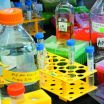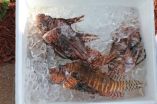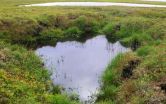(Press-News.org) San Antonio — July 31, 2014 — A new terrestrial bombardment model developed by an international group of scientists led by Southwest Research Institute (SwRI) indicates that Earth's surface was heavily reprocessed — or melted, mixed and buried — as a result of giant asteroid impacts more than four billion years ago.
The model, calibrated using existing lunar and terrestrial data, sheds light on the role asteroid collisions played in the geological evolution of the uppermost layers of Earth during the geologic eon call the "Hadean," or first geologic eon, approximately four to 4.5 billion years ago.
The team, which also included academic and government researchers, published its findings in a paper, "Widespread Mixing and Burial of Earth's Hadean Crust by Asteroid Impacts," in the July 31, 2014, issue of the journal Nature.
"Prior to approximately four billion years ago, no large region of Earth's surface could have survived untouched by impacts and their effects," said Dr. Simone Marchi, lead author of the paper and a planetary scientist in SwRI's Planetary Science Directorate in Boulder, Colo. "The new picture of the Hadean Earth emerging from this work has important implications for its habitability," Marchi said.
Large impacts had particularly severe effects on existing ecosystems. Researchers found that on average, Hadean Earth more than four billion years ago could have been hit by one to four impactors that were more than 600 miles wide and capable of global sterilization, and by three to seven impactors more than 300 miles wide and capable of global ocean vaporization.
"During that time, the lag between major collisions was long enough to allow intervals of more clement conditions, at least on a local scale," Marchi said. "Any life emerging during the Hadean eon likely needed to be resistant to high temperatures and could have survived such a violent period in Earth's history by thriving in niches deep underground or in the ocean's crust."
The research was supported in part by NASA's Solar System Exploration Research Virtual Institute (SSERVI) at NASA's Ames Research Center in Moffett Field, Calif.
"A large asteroid impact could have buried a substantial amount of Earth's crust with impact-generated melt," said Dr. Yvonne Pendleton, SSERVI director at Ames. "This new model helps explain how repeated asteroid impacts may have buried Earth's earliest and oldest rocks."
Terrestrial planet formation models indicate Earth went through a sequence of major growth phases: initially accretion of planetesimals — planetary embryos — over many tens of millions of years; then a giant impact that led to the formation of the Moon; followed by the late bombardment when giant asteroids several tens to hundreds of miles in size periodically hit ancient Earth, dwarfing the one that presumably killed the dinosaurs (estimated to be six miles in size), only 65 million years ago.
Researchers estimate that accretion during the late bombardment contributed less than one percent of Earth's present-day mass, but the giant asteroid impacts still had a profound effect on the geological evolution of early Earth. Prior to four billion years ago Earth was resurfaced over and over by voluminous, impact-generated melt.
Furthermore, large collisions as late as about four billion years ago may have repeatedly boiled away existing oceans into steamy atmospheres. Despite the heavy bombardment, the findings are compatible with the claim of liquid water on Earth's surface as early as about 4.3-4.4 billion years ago based on geochemical data.
The new research reveals that asteroidal collisions not only severely altered the geology of the Hadean eon Earth, but also likely played a major role in the evolution of life on early Earth as well.
INFORMATION:
The team was comprised of Marchi and Dr. William Bottke from SwRI; L. Elkins-Tanton from Carnegie Institution for Science in Washington; M. Bierhaus and K. Wünnemann from the Museum fur Naturkunde in Berlin, Germany; A. Morbidelli from Observatoire de la Côte d'Azur in Nice, France; and D. Kring from the Universities Space Research Association and the Lunar and Planetary Institute in Houston.
SSERVI is a virtual institute that, with international partnerships, brings science and exploration researchers together in a collaborative virtual setting. SSERVI is funded by the Science Mission Directorate and Human Exploration and Operations Mission Directorate at NASA Headquarters in Washington. For more information about SSERVI and selected member teams, visit: http://sservi.nasa.gov.
SwRI-led team's research shows giant asteroids battered early Earth
2014-08-01
ELSE PRESS RELEASES FROM THIS DATE:
Blood and saliva tests help predict return of HPV-linked oral cancers
2014-07-31
Physicians at Johns Hopkins have developed blood and saliva tests that help accurately predict recurrences of HPV-linked oral cancers in a substantial number of patients. The tests screen for DNA fragments of the human papillomavirus (HPV) shed from cancer cells lingering in the mouth or other parts of the body. A description of the development is published in the July 31 issue of JAMA Otolaryngology – Head & Neck Surgery.
"There is a window of opportunity in the year after initial therapy to take an aggressive approach to spotting recurrences and intensively addressing ...
Study of twins discovers gene mutation linked to short sleep duration
2014-07-31
DARIEN, IL – Researchers who studied 100 twin pairs have identified a gene mutation that may allow the carrier to function normally on less than six hours of sleep per night. The genetic variant also appears to provide greater resistance to the effects of sleep deprivation.
Results show that a participant with p.Tyr362His – a variant of the BHLHE41 gene – had an average nightly sleep duration of only five hours, which was more than one hour shorter than the non-carrier twin, who slept for about six hours and five minutes per night. The twin with the gene mutation also ...
Sustained efficacy, immunogenicity, and safety for GlaxoSmithKline's HPV vaccine
2014-07-31
A long-term follow-up study (HPV-023; NCT00518336) shows the sustained efficacy, immunogenicity and safety of GlaxoSmithKline's human papilloma virus (HPV) vaccine Cervarix. Women vaccinated with the HPV-16/18 AS04-adjuvanted vaccine were followed for more than nine years, and vaccine efficacy (VE) against incident infection was 100%. This is the longest follow-up report for a licensed HPV vaccine. Visit https://www.landesbioscience.com/journals/vaccines/article/29532/ for the full paper.
HPV and vaccination
Persistent infection with HPV has been clearly established ...
Algorithm reduces use of CT scans when diagnosing children with appendicitis
2014-07-31
ROCHESTER, Minn. — Implementation of an algorithm aimed to diagnose pediatric patients with suspected appendicitis reduces the utilization of computed tomography (CT) scans, without affecting diagnostic accuracy, Mayo Clinic Children's Center researchers have found. The study was recently published in the journal Surgery.
Acute appendicitis is the most common cause of acute abdominal pain in children. Appendicitis occurs when the appendix becomes inflamed and filled with pus. CT scans are often used to diagnose acute appendicitis because they are accurate, widely available ...
Study of bigeye tuna in Northwest Atlantic uses new tracking methods
2014-07-31
AMHERST, Mass. – A first-of-its-kind study of bigeye tuna movements in the northwestern Atlantic Ocean led by Molly Lutcavage, director of the Large Pelagics Research Center at the University of Massachusetts Amherst, found among other things that these fish cover a wide geographical range with pronounced north-south movements from Georges Bank to the Brazilian shelf, and they favor a high-use area off Cape Hatteras southwest of Bermuda for foraging.
This NOAA-funded research, which used a new approach to study one of the most important commercial tuna species in the ...
Unintended consequences: More high school math, science linked to more dropouts
2014-07-31
As U.S. high schools beef up math and science requirements for graduation, researchers at Washington University in St. Louis have found that more rigorous academics drive some students to drop out.
The research team reported in the June/July issue of the journal Educational Researcher that policies increasing the number of required high school math and science courses are linked to higher dropout rates.
"There's been a movement to make education in the United States compare more favorably to education in the rest of the world, and part of that has involved increasing ...
Is it really a concussion? Symptoms overlap with neck injuries so diagnosis is tough call
2014-07-31
BUFFALO, N.Y. – Athletes and others reporting cognitive difficulties after a head injury are usually diagnosed as having had a concussion. But is it really a concussion? A new study published by University at Buffalo medical faculty finds that many of the same symptoms are common to concussions and to injuries to the neck and/or balance system, known collectively as cervical/vestibular injuries.
The research was based on responses about symptoms from 128 patients – some of whom were professional athletes – who were being treated at UB's Concussion Management Clinic in ...
Invasive lionfish likely safe to eat after all
2014-07-31
Scientists have learned that recent fears of invasive lionfish causing fish poisoning may be unfounded. If so, current efforts to control lionfish by fishing derbies and targeted fisheries may remain the best way to control the invasion. And there's a simple way to know for sure whether a lionfish is toxic: test it after it's been cooked.
Pacific lionfish were first reported off the coast of Florida in the 1980s, and have been gaining swiftly in number ever since. They're now found in marine habitats throughout the tropical and subtropical Western Atlantic, Caribbean ...
Certain Arctic lakes store more greenhouse gases than they release
2014-07-31
New research, supported by the National Science Foundation (NSF), counters a widely-held scientific view that thawing permafrost uniformly accelerates atmospheric warming, indicating instead that certain Arctic lakes store more greenhouse gases than they emit into the atmosphere.
The study, published this week in the journal Nature, focuses on thermokarst lakes, which occur as permafrost thaws and creates surface depressions that fill with melted fresh water, converting what was previously frozen land into lakes.
The research suggests that Arctic thermokarst lakes ...
NASA's Fermi space telescope reveals new source of gamma rays
2014-07-31
Observations by NASA's Fermi Gamma-ray Space Telescope of several stellar eruptions, called novae, firmly establish these relatively common outbursts almost always produce gamma rays, the most energetic form of light.
"There's a saying that one is a fluke, two is a coincidence, and three is a class, and we're now at four novae and counting with Fermi," said Teddy Cheung, an astrophysicist at the Naval Research Laboratory in Washington, and the lead author of a paper reporting the findings in the Aug. 1 edition of the journal Science.
A nova is a sudden, short-lived brightening ...





